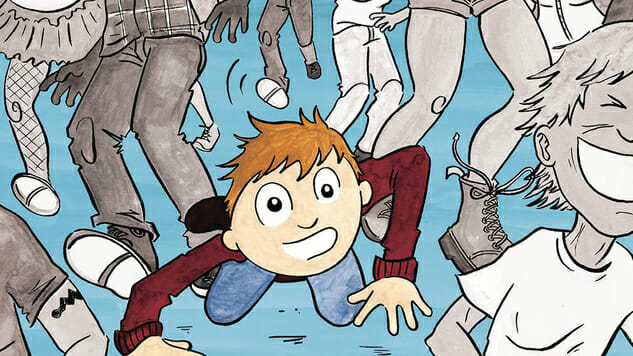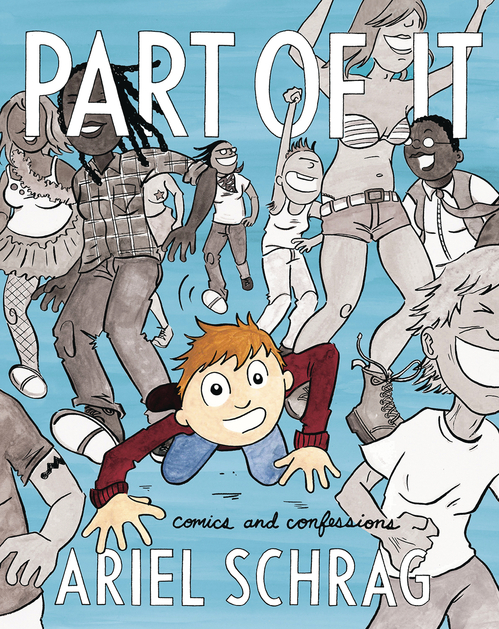Part of It Cartoonist Ariel Schrag on Openness, Immediacy & the Right Pair of Glasses
Art by Ariel Schrag
If there’s a word that describes Ariel Schrag’s comics, it’s “immediacy.” Her work—whether her early stuff, created while she was a young high-schooler, or her more recent comics—feels like it’s poured straight from her brain onto the paper. Sometimes that’s not a good thing. Work that comes across so unfiltered can be weak or unfocused. But Schrag makes it work, even when her drawing is less polished (it gets more so) and her narratives don’t drive toward a clear point. She flays herself for her reader but also in what seems like a process of unburdening herself. Part of It: Comics and Confessions includes work that’s been published elsewhere but also some that hasn’t. It doesn’t go up to the present, but it does cover parts of Schrag’s life from age six to 26, which one might call the most important years of forming one’s personality. It seems especially meaningful if you came of age around the same time Schrag did, or at least that’s how I read it, as I can’t help but do otherwise. The bands, the clothing styles, the ways in which friends hung out, the relative lack of technology, the desperate desire to find one’s people and seem cool—all of it hits me straight in the gut. She’s like a more hard-edged Leslie Stein, with her wide-eyed characters eager to take in the world. Schrag managed to find a few minutes between chasing her toddler to answer some questions about where she came from as an artist and how she remembers her past so clearly.
![]()

Part of It: Comics and Confessions Cover Art by Ariel Schrag
Paste: You started publishing your comics while you were still in high school. What gave you the self-confidence to do that?
Schrag: I wrote my first comic, Awkward, about my freshman year of high school because I wanted a fun activity to do over the summer. I wasn’t initially planning on publishing it. When I finished, I felt proud of it, but didn’t know what to do, so it just sat in my drawer. I finally asked my mom, “What am I doing with my comic?” and she said, “Well, why don’t we go down to the photocopy store and make copies and you can sell them.” So I did, for five dollars to friends and family. Everyone seemed to like it, which gave me the motivation to do another.
Paste: Did your mom read your comic before she suggested you photocopy it? It seems like your parents were pretty hands-off. Have they always been supportive?
Schrag: Both of my parents were always supportive of my comics, even when the comics depicted me doing sexual things and drinking and smoking pot and, most graciously, even when I depicted my parents themselves in a less than flattering light. Before I gave them the comics to read I would say, “You’re allowed to comment on the art, but not the content.” And they always respected that.
Paste: Do you think growing up in Berkeley presented you with a wider range of possible experiences than growing up in, say, rural Idaho would have?
Schrag: Growing up in Berkeley, I definitely had access to a lot of cool places and events. I went to my local comic book shop, Comic Relief, every day after school. I saw bands on the weekends at clubs like Gilman and Berkeley Square. Being in a town that celebrated diversity, peace and freedom of expression (sometimes successfully, sometimes not) also had a big effect on my psyche.
Paste: Did you grow up reading comics?
Schrag: The first comics I read were newspaper strips like Calvin and Hobbes, Blondie and For Better or For Worse and I loved them. I was also really into the Disney Uncle Scrooge comics. I knew I wanted to be a cartoonist from about age 10, and when I discovered alternative and autobiographical comics such as Maus, Deep Girl, Optic Nerve, Eightball and Peepshow, I knew what kind of cartoonist I wanted to be.
-

-

-

-

-

-

-

-

-

-

-

-

-

-

-

-

-

-

-

-

-

-

-

-

-

-

-

-

-

-

-

-

-

-

-

-

-

-

-

-








































